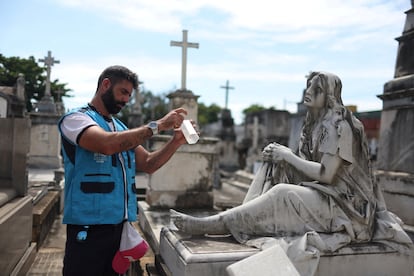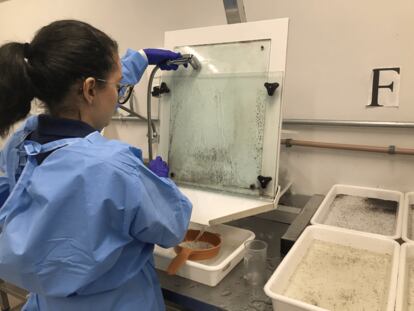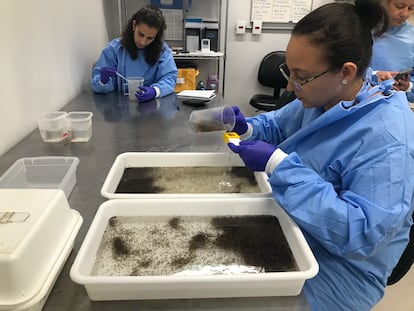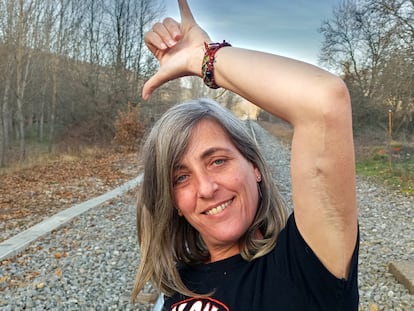Niterói, the Brazilian city that has been releasing mosquitoes to stop dengue
The promising results have followed the introduction of laboratory-bred insects into the environment. This has encouraged other municipalities to replicate this method, which was discovered in Australia and has since been used in 14 countries


To enjoy one of the most beautiful views of the city of Rio de Janeiro, the best option is to take the ferry, cross the Guanábara Bay — as thousands of people do every day — and, in 20 minutes, disembark in the opposite city, Niterói. From there, watching the sunset over the most famous city in Brazil is priceless, and while it’s advisable not to let your guard down, the chances of contracting dengue are much lower.
Niterói — a commuter city that has a flying saucer-shaped museum designed by Oscar Niemeyer — is building a reputation as a model city in the face of the dengue crisis, which is especially acute this year in Brazil and the rest of Latin America. Its incidence rate is 187 cases per 100,000 inhabitants, or around seven times less than the average in Brazil or in Rio (1,401 per 100,000 inhabitants), according to official data from the Ministry of Health.
Part of the secret behind this success is the massive release of modified mosquitoes, which Brazilians have nicknamed wolbitos. They’re a variant of Aedes aegypti, to which the Wolbachia bacteria was introduced in laboratories. This bacteria reduces the mosquitoes’ ability to transmit dengue and other diseases, such as Zika, chikungunya or yellow fever.

“We’ve gone from just being research, an experiment, to being an instrument of public policy, because the Ministry [of Health] has adopted this method,” explains Diogo Chalegre, 40, the director of institutional relations at the Wolbachia Project in Brazil. Once the misgivings regarding the results of the first experiments eased, interest in the research increased, because the dengue crisis is especially serious throughout Latin America. So far this year, Brazil has recorded more than 1,100 deaths from the disease, while another 1,800 are being examined. The national incidence rate is 1,460 cases per 100,000 inhabitants, double that of a year ago.
All those involved in the Wolbachia Project emphasize that there’s no type of genetic modification being done. Rather, the method involves the injection of a natural microorganism into the mosquitoes, which is present in 60% of insects on the planet.
The periodic dissemination of millions of mosquitoes for just over eight years has managed to replace the original Aedes aegypti in Niterói (which don’t have the Wolbachia bacteria) with the modified ones, the wolbitos, which don’t infect people. The World Mosquito Program (WMP) breeds them in a laboratory within the Oswaldo Cruz Foundation, a Rio de Janeiro- based public health institution inspired by the Pasteur Institute, a French non-profit foundation dedicated to the study of diseases.
Everything indicates that this modification works. Catia Cabral, a 46-year-old biologist, explains how during an interview with EL PAÍS at the mosquito farm. “The difference between our method and others is that we don’t want to eliminate the mosquitoes: we want to replace the population of Aedes aegypti with our mosquitoes, which have Wolbachia.”
Cabral is in charge of the hatchery, which she manages alongside her team. It’s a laboratory with several environments set at different temperatures. The site should be entered with the minimum amount of exposed skin, because the mosquitoes are unforgiving.

There, the scientists grow thousands of eggs in trays of water, feed the larvae with liver paste and fish meal, carefully separate the females from the males with a device that distinguishes them by size, all while counting them with infinite patience (and a kind of spoon). Every couple of days, they observe the insects. When they become adults, they’re fed a cocktail of human and animal blood. The largest enclosures are like mosquito nets the size of a refrigerator: they house about 80,000 specimens. Some of the lab-grown mosquitoes are released in the Brazilian cities that participate in the program. The rest remain, so that they can lay eggs and restart the cycle.

Niterói’s Secretary of Health Anamaría Schneider calls the modified insects “good mosquitoes.” She still remembers the astonishment and suspicion of the former mayor when, back in 2015, the Oswaldo Cruz Foundation (FIOCRUZ) and the WMP proposed that the municipality, with half-a-million residents, host a pilot project. He thought they sounded delirious.
“[The mayor] got scared and said: how? All the mayors are killing them… and they want me to release more mosquitoes?” she recalls. In the end, however, he accepted. Because, Schneider explains, “he trusted in the science and credibility of FIOCRUZ.” And, what’s more, it’s free for the city. Data from the Brazilian Ministry of Health cited by the WMP indicates that for every Brazilian real invested in this project (one real is equivalent to $0.20), there’s a return of between 44 and 550 reals (between $8.60 and $107) in healthcare savings.
The secret is in the females
The key to this method, which was discovered in Australia, is the females. Cabral explains that they transmit the bacteria which stops the contagion to their offspring. And, gradually, one population is replaced by another. From time to time, the researchers capture mosquitoes to check how the replacement of the originals with the modified ones is progressing. This is important for the success of the mission, because the mosquitoes don’t travel far, only about 330 feet at most. And they live for about a month.
The promising results in Niterói and in the other cities that have embraced the method — implemented in 14 countries by the World Mosquito Program — have increased its appeal and demand. Six more cities spread throughout Brazil (Natal, Uberlandia, Presidente Prudente, Londrina, Foz de Iguaçu and Joinville) are preparing to receive modified mosquitoes starting in June of this year, meaning that 11 Brazilian cities will soon be participating in total. For this, they’ll require many more mosquitoes than what can currently be produced in labs. For this reason, WMP Brazil is building a macro farm. If they now breed 40 million mosquitoes carrying the Wolbachia bacteria every month, within a year, they expect to increase the total number of insects to 400 million per month, according to Chalegre, the director of institutional relations at the Wolbachia Project.
Based on the pilot project that began in a Niterói neighborhood, new districts were added and, in seven years, the entire city was covered. But the secretary of health emphasizes that mosquitoes are part of a strategy that encompasses many other actions. The secret is the combination of all of them, including campaigns to avoid stagnant water in homes (such as in wells and flower pots), utilizing pest repellent and avoiding black clothes, which — for reasons that are unknown — mosquitoes love.
“We have 300 zoonosis control agents who visit 6,000 buildings a day,” Schneider explains. The City Council has specific equipment to enter abandoned buildings. And, of course, there’s also the vaccine. Brazil is the only country (for now) that supplies it via the public healthcare system.
Belo Horizonte, Campo Grande and Petrolina are the other cities where the breeding method is being used. When the release of lab-modified mosquitoes against dengue began in Niterói, the health official recalls that it wasn’t easy to convince the residents. To do this, the City Council turned to family doctors, who, inspired by the Cuban system, live in the neighborhoods where they serve. These physicians were in charge of explaining the details of the innovative method to community leaders and neighborhood associations. “We managed to convince them… it was a painless job,” Schneider smiles.
Today, Niterói is reaping the fruit from all the years when this project was implemented, while dengue was causing much greater damage on the other side of the bay, in the city of Rio de Janeiro. There, they’ve also applied the Wolbachia system, but on a much smaller scale. There’s also the added difficulty posed by armed groups that control entire neighborhoods in Rio: according to Chalegre from WMP, this makes the implementation and monitoring of the project very difficult.
Sign up for our weekly newsletter to get more English-language news coverage from EL PAÍS USA Edition









































